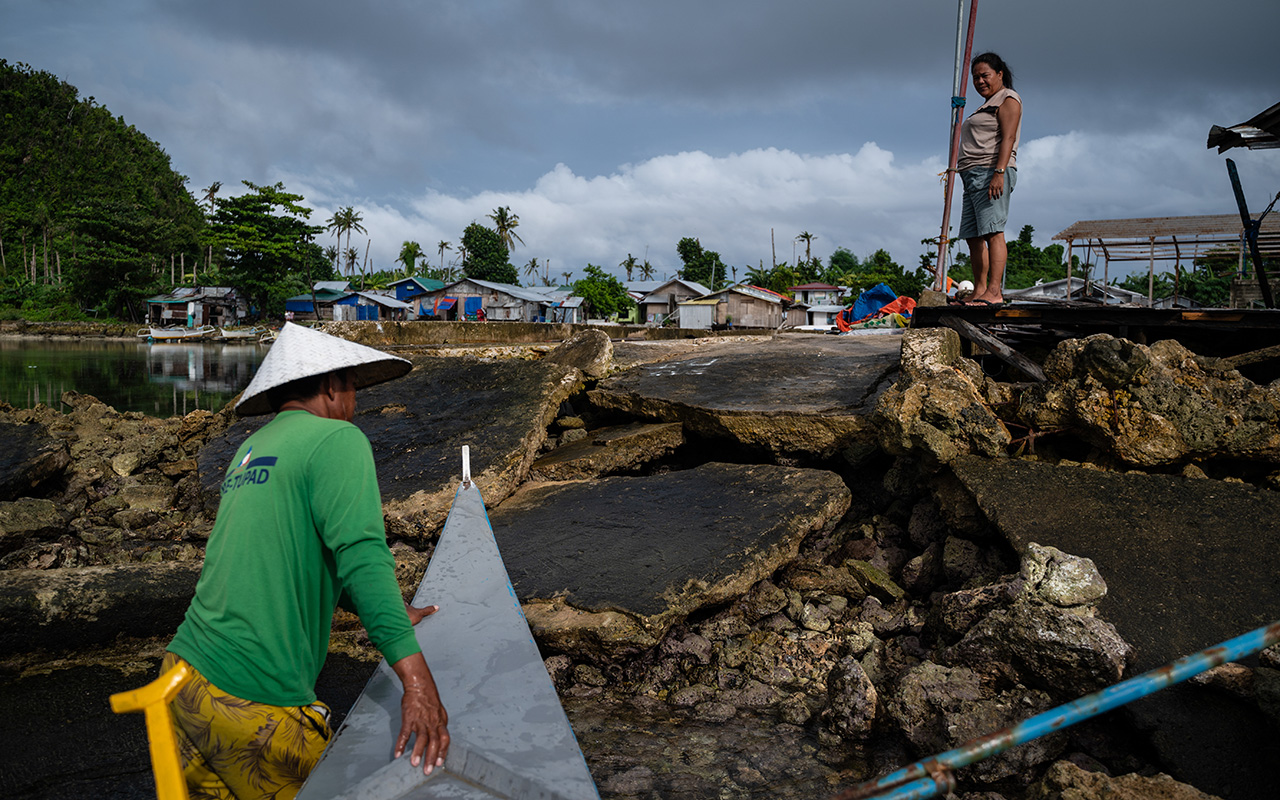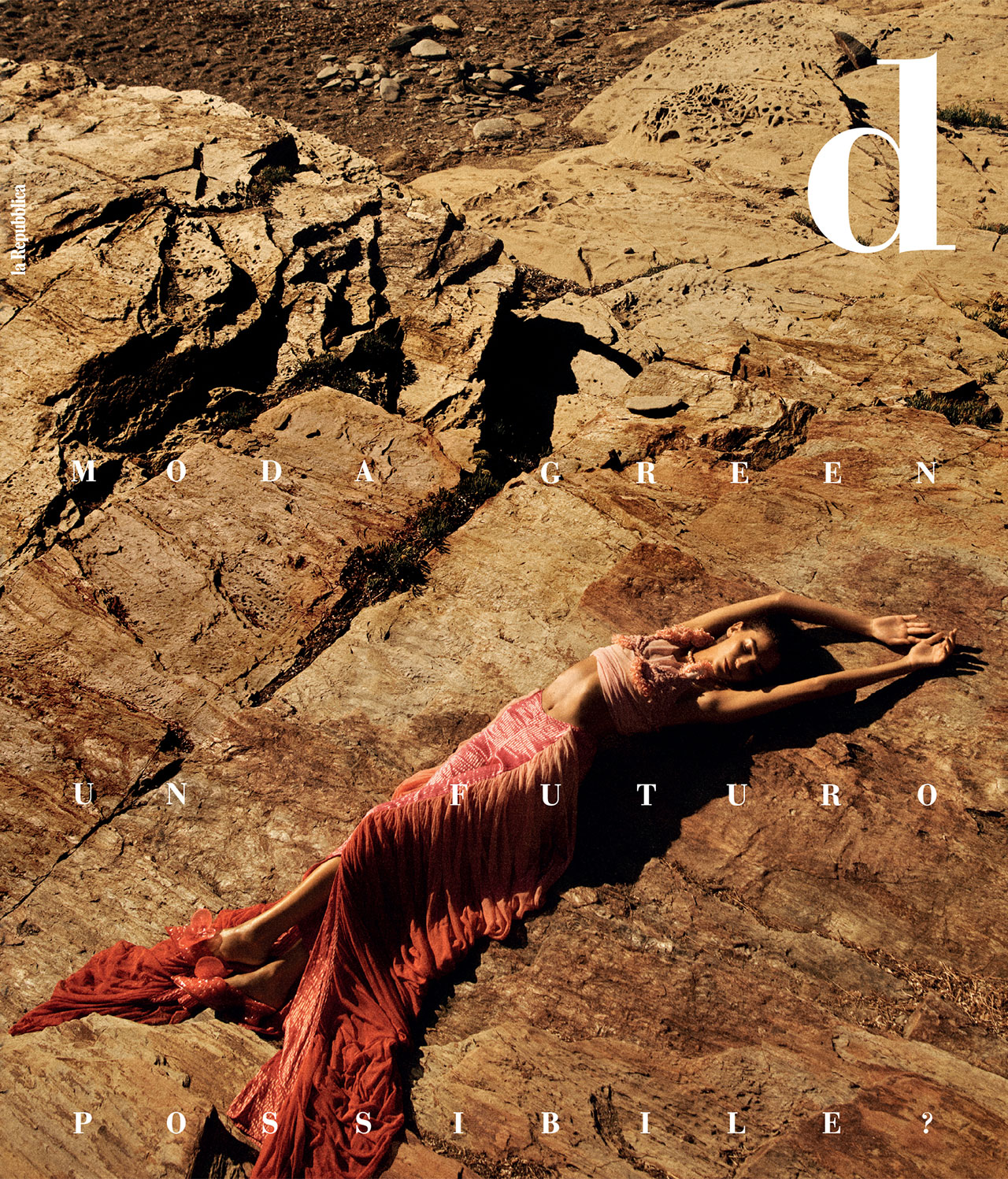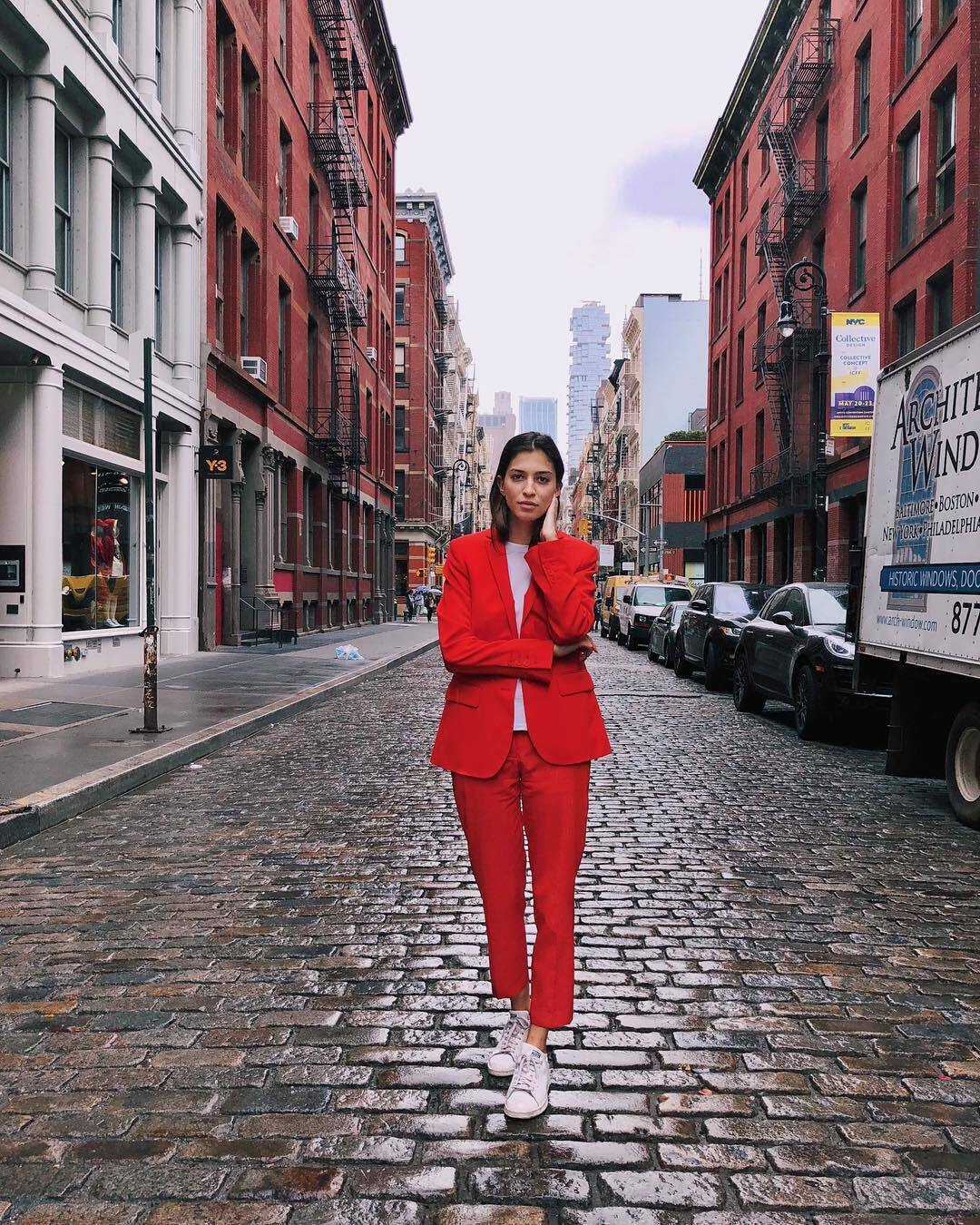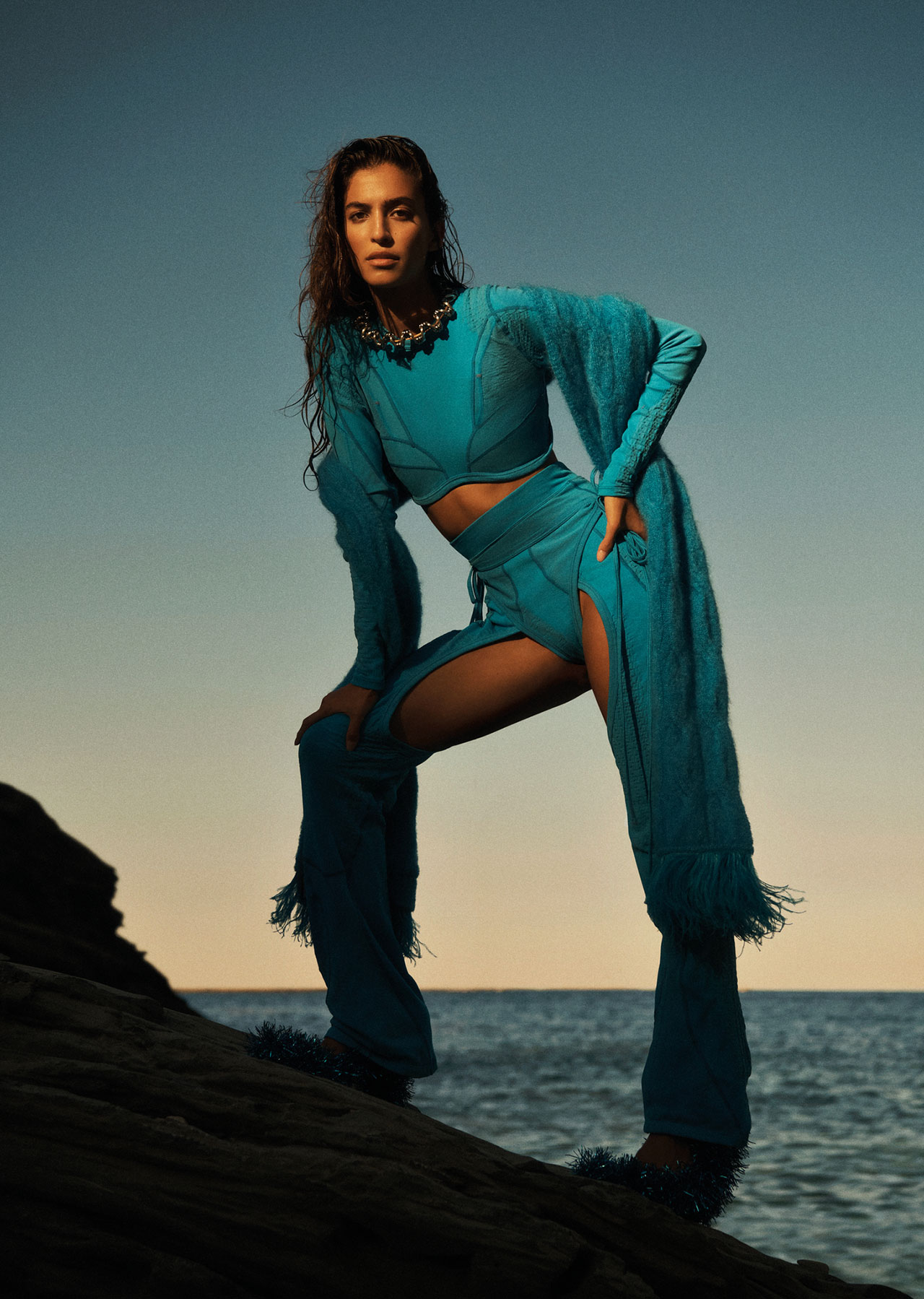In a fashion landscape constantly pursuing the ‘next big trend,’ Marina Testino stands out as an advocate for conscious consumerism, steering clear of the conformities dictated by fleeting trends. With a name translating to “of the sea,” her environmental consciousness has been rooted since childhood, surrounded by nature and her father’s turtle rescue initiative in Tulum. After fashion internships in styling, PR, and production, leaping to modeling, and founding a clothing brand Point Off View, Testino gained a 360-degree view of an industry plagued by excessive waste. This foundation led her to head impactful digital initiatives to bring awareness to conscious consumption like One Dress to Impress, where she wore the same red suit daily for two months, and Yellow Like a Lemon, where Testino sourced clothes exclusively from what she calls the Four S’s of Sustainable Fashion: Simplify, Second Hand, Sustainably Sourced, Shared. Testino also curated Sustainable Fridays to highlight environmentally conscious brands and started her web series, Green Rooms, where she speaks to a wide range of professionals in the sustainability space. Now, as the Director of Strategic Partnerships at Earth Partner, a subdivision of Art Partner, she unites voices, brands, and platforms for positive climate impact in fashion. This includes coordinating partnerships and sponsors for initiatives like #CreateCOP28, a prize competition that generates conversations around the urgent need for climate action and raises awareness of the crucial decisions made at COP28, the United Nations’ annual climate summit. Just as the 2023 winners like Gab Meija and more were recently announced, Models.com spoke to Testino about her journey to self-acceptance and her vision for an ethical and sustainable future.

Image by Andres Leon | Image courtesy of Marina Testino/Point Off View
What was your relationship with sustainability growing up?
I grew up in a family that has always been very conscious of environmental issues. From a young age, my dad took us to Tulum, and given that my name is Marina, meaning ‘of the sea,’ I’ve always felt a strong connection to the ocean. Most of my childhood memories involve being by the sea. My dad even established a turtle rescue organization in Tulum to address the pressing issue of people consuming turtles and other related problems. Our home became a hub for turtle protection, with nests waiting for the eggs to hatch. During our visits, we would release the baby turtles into the ocean. This experience played a significant role in shaping my childhood.
As the Director of Strategic Partnerships at Earth Partner, can you share how you’ve collaborated with clients to implement and advocate for sustainable practices?
Earth Partner operates as a subdivision of our larger partner, Art Partner. Leveraging Art Partner’s extensive network and platform within the industry, Earth Partner was created to establish connections between sustainability and fashion, bringing together organizations, brands, platforms, voices, and individuals to make a positive impact on the climate through the fashion industry. My role involves ideating projects that create positive impacts, such as coordinating partnerships and sponsors for initiatives like Create COP. Additionally, I contribute to the selection of the jury. While Art Partner boasts an impressive roster within the fashion industry, my focus is on expanding the roster within the sustainability space and finding ways to raise awareness within the industry about connecting with sustainable organizations for a more positive impact.

The Passage of Storms by Gab Meija | Image courtesy of Earth Partner
Speaking of #CreateCOP, as it just reached its fourth anniversary, could you reflect on how you’ve seen the competition evolve over the years? What inspires you about the creative artworks submitted throughout the years?
#CreateCOP has been an amazing initiative, especially because nowadays, we live in a world filled with extensive articles on the climate crisis that often go unread by the average person. The sheer volume of information has left many feeling overwhelmed and detached unless they are directly impacted by a natural disaster. #CreateCOP has bridged this gap by translating art into a tangible representation of reality. The submitted projects, whether through photography, film, or other mediums, capture the real-life experiences of people facing the climate crisis at their doorstep. The competition serves as a powerful reminder that the climate crisis isn’t just about numbers on paper; it’s a harsh reality for many. #CreateCOP has not only raised awareness but also provided a platform for creators and artists experiencing the effects of the climate crisis. The growth of participation, doubling from the previous year, and the involvement of over a hundred countries, including places like the Philippines and Pakistan, showcase the expanding reach of the initiative. By broadening our jury and outreach efforts, we’ve successfully engaged people from various corners of the globe, making #CreateCOP an incredible project for both awareness and showcasing the talents of those affected by the climate crisis.

Image courtesy of Marina Testino/Point Off View
Could you describe the process of producing D Magazine’s ‘Green Issue,‘ released in conjunction with COP27, and explain the intention behind it?
Our initial pitch aimed at a sustainable story, which organically evolved into the entire issue adopting a sustainable theme, featuring me on the cover. The central idea was to demonstrate that sustainable fashion could be both stylish and vibrant. We wanted to present a fashion story that emphasized clothing and style, encouraging readers to envision themselves wearing the showcased clothes. Anastasia Barbieri, the stylist, collaborated with me to curate a selection of sustainable brands. Lachlan Bailey was the photographer, capturing our images in Port Lligat, a beach town in Spain I visit every summer. This town holds special significance as it was where Salvador Dalí drew inspiration for 70% of his paintings. I thought it was the perfect location for our shoot. We also wanted to minimize the carbon footprint, so we deliberately chose European brands, predominantly working with Spanish brands, to avoid unnecessary shipping from various locations. Maintaining a commitment to sustainability, we ensured there was no single-use plastic on set. Composting and recycling were integral aspects of our shoot.
Beyond fashion, how else do you practice eco-living and sustainable living?
Embracing a minimalist approach to packing, I often travel with just a carry-on. Fortunately, wherever I go, I have friends, and I let them know in advance about what I might need, allowing me to borrow items like dresses and boots from their closets. My commitment extends to avoiding single-use plastic, recycling, and composting. On a related note, I recently bought a trash can from a company called The Mill, which offers a compost trash can. The system crushes vegetables and organic waste overnight, turning them into nutrient-rich soil. This innovative solution addresses the issue of food waste, preventing it from ending up in landfills alongside non-biodegradable materials. I love it. It’s like my little baby; every day I take pictures of what I throw in the night before and how it turns into soil the next day.
What suggestions do you have for price-conscious consumers seeking to be more ethical in their shopping experiences?
The most sustainable approach, in my opinion, is borrowing from friends or family members. Given the ongoing wedding season, chances are you know someone with a dress that you could borrow for the occasion. While societal norms often discourage outfit repetition, and we can’t change that, we can change how we source our outfits for specific events. Rentals are a great option for special occasions, providing a more sustainable alternative. Mindfulness while shopping is also crucial. Consider whether you’ll use an item more than 30 times or if it only aligns with a fleeting trend. When I did the red suit campaign, it shifted my mindset, prompting me to rethink each purchase. Ask yourself, “Do I genuinely need it? Does it complement something already in my closet?” This simple question can guide more conscious consumer choices.

D Repubblica November 2022 Cover: The Green Issue by Lachlan Bailey | Image courtesy of Marina Testino/Point Off View
I understand that you’ve started social media activations, such as the One Dress to Impress. Could you expand on the impact of digital activism and the use of art to raise awareness about conscious consumerism?
The One Dress to Impress campaign was my first campaign. The motivation behind this campaign stemmed from my specific vantage point in the fashion industry. Having journeyed through fashion internships, modeling, and creating a clothing brand, Point Off View. I gained a comprehensive understanding of the industry, witnessing its different facets. This 360-degree perspective revealed the industry’s shortcomings, particularly in terms of excessive waste. Recognizing the scope of the waste problem, I felt that I had to use my platform and voice differently instead of conforming to the narrative of portraying a specific influencer lifestyle. I wanted to address the disconnect between the industry’s image and its environmental impact. The inspiration for One Dress to Impress originated from during my first fashion week as a model, I found myself changing outfits multiple times for different events, projecting an image on social media that didn’t align with the reality of being so hungry each day and just changing clothes. I was following what everyone else was doing, and I just wanted to fit in. Eventually, I started asking myself, “What’s the point?” Then two weeks later, I went to an event for a brand, and they told me to pick an outfit from their lookbook, so I chose this red suit and wore it to the event. Two weeks later, the same brand had a new event and capsule collection. They asked me to choose a piece and I said, “It’s okay. I’ll wear my red suit from last time.” I went to the event only to be confronted by three people who noticed I had worn the same suit at a previous event. I was 23 and felt so embarrassed, and it really just broke me. That feeling ignited a realization: “Why should I feel guilty about repeating an outfit I loved, felt comfortable in, and looked good wearing?” This perception, coupled with the pressure to constantly consume, sparked the idea of the challenge. I started a two-month challenge to repeat the same outfit every day. It was also a personal challenge as I’m a very shy person, so it pushed me out of my comfort zone and showcased what I stand for. Despite facing resistance from my entire family and industry norms, I was committed to showcasing that sustainability goes beyond talk; it requires action. After this, I told my agency that I would only work with sustainable brands or positive impact projects. This decision marked a turning point in my career, emphasizing my dedication to aligning my work with my values. Prioritizing conscious consumerism, I wanted to voice the message that anyone can contribute to the movement.
“I hope to see movement on investments in climate solutions. These funds are critical to facilitate research and innovation, fast-track the transition to clean energy, and push forward the climate-positive projects and policies we need.”
What was the inspiration behind the “Yellow like a Lemon” campaign?
Yellow like a Lemon was the second campaign, launching during fashion month. About two weeks before Paris, I made the spontaneous decision to start this campaign. I began reaching out to every sustainable brand, rental company, and secondhand business, expressing my intention to be in Paris and inviting them to participate in the activation. I left New York with only one pair of yellow jeans and two yellow shirts and just prayed to find more pieces in Paris, and to my surprise, many brands were excited to be part of the initiative. The brands were drawn to the messaging and the concept of altering the perception of sustainable fashion. I wanted to challenge the stereotype that wearing sustainable clothing meant sacrificing style or color. The campaign spanned two months and was the perfect activation to follow “One Dress to Impress,” recognizing that wearing the same outfit for an extended period might not be practical for everyone. Instead, it focused on showcasing the accessibility of sustainable fashion. The message was clear: you can borrow, rent, or buy secondhand and still be a conscious consumer. Why did I choose the color yellow? The concept was to challenge me to wear the hardest color for two months sustainably, proving that sustainable fashion is not limiting. The choice of yellow also served as a conversation starter.
I know that you have collaborated with brands and organizations such as UGG, Greenpeace, the UN, and Davines. Can you further explain how you’ve worked with these brands and organizations?
My collaborations with brands and organizations vary in nature. With organizations like Greenpeace, I’ve joined forces for specific campaigns. For instance, the “We See Through” activation focused on microplastics in the ocean. I partnered with Greenpeace to ensure that the campaign was well-informed and backed by accurate facts.With UGG, I not only modeled for their Regenerate campaign but also organized an experiential event to launch it. The event included mixology and cookie decorating classes, offering an engaging way to learn about the collection and regenerative agriculture’s impact. For Davines, I visited their EROC, the first hub in Europe dedicated to studying and showcasing regenerative agriculture. In addition to modeling, I consulted and assisted them in effectively communicating their projects in a visually appealing, digestible, and interactive way.

Image courtesy of Marina Testino/Point Off View
In your Green Room series, I know you’ve spoken with a wide range of professionals in the fashion skincare and PR spaces, such as Suzanne Kaufman, Laura Balmond, and Shannon Welch, among others. How do you select your guests, and what do you aim for viewers to take away after watching?
The Green Room series was designed to empower women in the sustainability space, as they often don’t receive enough credit despite being the driving force behind positive change. The concept revolves around elevating women making strides in different industries within the sustainability mission. By shedding light on various sectors and industries, I hope to inspire individuals in the same industries to see how they, too, can contribute to the sustainability mission. Each interview focuses on the guest’s answer to the question, “What suggestions do you have for someone as an individual to make a change in sustainability?”
With COP 28 on the horizon, what are your hopes regarding initiatives to combat climate change or the discussions around that?
On top of phasing out fossil fuels, the number one initiative I hope to see movement on is investment in climate solutions. Private and public sectors need to come together to finance these solutions and help us reach our goals. These funds are critical to facilitate research and innovation, fast-track the transition to clean energy, and push forward the climate-positive projects and policies we need. They are also so important for the vulnerable communities who are adapting to the changes that are already occurring and deserve help that is affordable, available, and accessible.

The Green Issue by Lachlan Bailey | Image courtesy of Marina Testino/Point Off View

